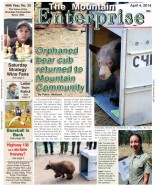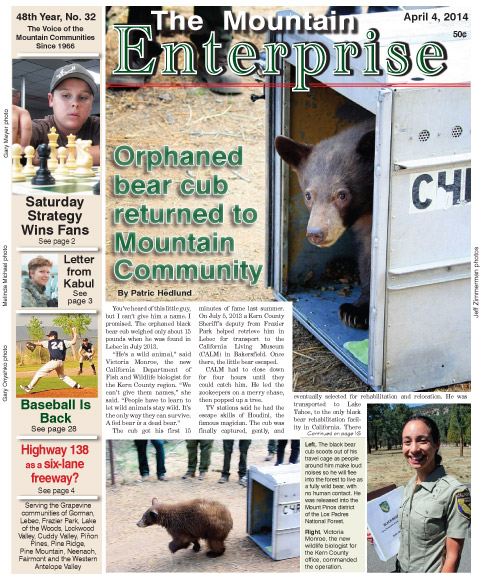![The 60-pound black bear cub peers out from a travel crate before bolting into the forest. See the video on this page. [photo by Jeff Zimmerman]](https://mountainenterprise.com/wp-content/uploads/MG_8781news2_web-324x216.jpg)
Image 1 of 4
The 60-pound black bear cub peers out from a travel crate before bolting into the forest. See the video on this page. [photo by Jeff Zimmerman]![Little bear...big crowd [photo by Patric Hedlund]](https://mountainenterprise.com/wp-content/uploads/LittleBEARBigCrowd_cmyk-324x243.jpg)
Image 2 of 4
Little bear...big crowd [photo by Patric Hedlund]![The black bear cub scoots out of his travel cage as people around him make loud noises so he will flee into the forest to live as a fully wild bear, with no human contact. He was released into the Mount Pinos district of the Los Padres National Forest. [photo by Jeff Zimmerman]](https://mountainenterprise.com/wp-content/uploads/MG_8784news_cmyk-324x216.jpg)
Image 3 of 4
The black bear cub scoots out of his travel cage as people around him make loud noises so he will flee into the forest to live as a fully wild bear, with no human contact. He was released into the Mount Pinos district of the Los Padres National Forest. [photo by Jeff Zimmerman]![Victoria Monroe, the new wildlife biologist for the Kern County office, commanded the operation. [photo by Jeff Zimmerman]](https://mountainenterprise.com/wp-content/uploads/MG_8757news_cmyk-266x400.jpg)
Image 4 of 4
Victoria Monroe, the new wildlife biologist for the Kern County office, commanded the operation. [photo by Jeff Zimmerman]
The black bear cub is released in the Los Padres National Forest on March 25, 2014 [video by DFW Volunteer Jeff Warner].
By Patric Hedlund
You’ve heard of this little guy, but I can’t give him a name. I promised. The orphaned black bear cub weighed only 15 pounds when he was found in Lebec in July 2013.
“He’s a wild animal,” said Victoria Monroe, the new California Department of Fish and Wildlife biologist for the Kern County region. “We can’t give them names,” she said. “People have to learn to let wild animals stay wild. It’s the only way they can survive. A fed bear is a dead bear.”
The cub got his first 15 minutes of fame last summer. On July 5, 2013 a Kern County Sheriff’s deputy from the Frazier Park substation helped retrieve him in Lebec for transport to the California Living Museum (CALM) in Bakersfield. Once there, the little bear escaped.
CALM had to close down for four hours until they could catch him. He led the zookeepers on a merry chase, then popped up a very tall tree.
TV stations said he had the escape skills of Houdini, the famous magician. The cub was finally captured, gently, and eventually selected for rehabilitation and relocation. He was transported to the only black bear rehabilitation facility in California, in Lake Tahoe. The cub spent eight months there learning to forage for food and water in the wild. Most importantly, he was conditioned to stay away from human dwellings.
The decision to bring the yearling, now 60 pounds, back to these mountains was cause for high excitement among personnel of the California Department of Fish and Wildlife (formerly “Department of Fish and Game”). Wildlife biologists and volunteers drove from Sacramento, Fresno, Tulare and Bakersfield to be part of the expedition.
The Mountain Enterprise was invited to join the release party, explained CDFW public information officer Janice Mackey, because this is a “good news” story, following our reporting in November 2013 about the hazards to bears when people who live near wild habitat are careless or irresponsible or filled with romantic notions of becoming “friends” with black bears.
The story last year ended tragically, when a mature, 350-pound male bear had to be killed by a USDA hunter because the bear had become dangerous. The big male and another black bear companion first broke into a garage on Juniper Court in the Pine Mountain community, then pulled the front door off its hinges to enter the home. A couple woke, startled, to find the two bears inside their home, just outside their bedroom.
Denizens of an internet chatboard in the area spun conspiracy stories, alleging the bears were a mother and a cub (though none of them had seen the bears). CDFW scientists were frustrated that it was the humans’ careless feeding of the bears when they were smaller that caused the animals to imprint on human dwellings as a source of food. They lost their fear of people.
“That fear is the animals’ greatest defense against getting into trouble,” Wildlife Biologist Evan King of Tulare said. Last July it was he who drove this present cub to Lake Tahoe for training.
“We have a robust black bear population here,” said Monroe. “Bear problems will increase unless people who live near them understand the facts.
“Keep Me Wild” is the new CDFW spring campaign. “Feeding Wildlife is Dead Wrong,” is their slogan, along with “If You Care, Leave Them There.”
They plan to provide two Town Halls in this region in the coming two months, they said, to explain the ‘Keep Me Wild’ effort to the residents of the Mountain Communities.
Watch these pages for the Town Hall date and time.
Photo captions (see all the photos in the e-edition or in the newspaper on newsstands now):
The black bear cub scoots out of his travel cage as people around him make loud noises so he will flee into the forest to live as a fully wild bear, with no human contact. He was released into the Mount Pinos district of the Los Padres National Forest.
Victoria Monroe, the new wildlife biologist for the Kern County office, commanded the operation.
As the door was pulled up to free the 60-pound yearling from his travel cage, a scrum of Fish and Wildlife paparazzi stood behind the cage, then made a loud roar to help propel the bear into the forest, and to discourage any interest in being near people. Right, CDFW Wildlife Biologist Victoria Monroe handled logistics and planning for the project. Far right, Senior Environmental Biologist Marc Kenyon drove the bear from Lake Tahoe to return him to these mountains.
This is part of the April 4, 2014 online edition of The Mountain Enterprise.
Have an opinion on this matter? We'd like to hear from you.


